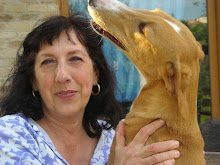Webmistress’s addendum (6/1/10): A few years after this article was written Dr Couto discovered that presumed FCE incidents in greyhounds are caused by blood clots, not by cartilagenous material. Treating this condition with steroids is not recommended unless actual cartilaginous material is present; it is critical to determine if the material causing the problem is disk material or from blood clots.The OSU Greyhound Wellness Program Spring-Summer 09 newsletter has an article about this. Access to the article is for members only. Please read Aortic Thromboembolism: Are Greyhounds at Risk? for a better understanding of what may be happening if your greyhound “goes down” or “throws a clot.”
By Laura Culbert, DVM
Greyhounds have been bred for superior athleticism. Their endurance and heavy hind limb muscle mass make them the fastest of all canines. Because of this, it is in question whether they may be predisposed to a condition that greyhound owners or breeders should be aware of. The condition is termed Fibrocartilaginous emboli (FCE). This can affect ambulation by causing a blood clot in the vessels that supply the spinal cord.
The source of FCE is presumed to be extruded intervertebral disk material. However, the pathway of entry of this material into the blood vessels is not clearly understood. Arteries and veins can contain blood clots. In theory, numerous vessels must be obstructed to cause spinal cord injury.
Direct entrance of fibrocartilage into a spinal artery or vein during acute disk herniation has been the proposed mechanism for FCE. The extrusion of disk material can sometimes tear the artery, creating bleeding in or around the spinal cord. This leads to the injury and varying degrees of paralysis or types of gait abnormalities.
Trauma and vigorous exercise seem to play an important role in the production of FCE. The stress placed on the spine in such activity increases the chance of acute disk herniation.
The incidence of FCE in dogs is unknown but is considered rare. Cheshire Veterinary Hospital sees an estimated fifteen to twenty cases per year. Large and giant breeds in addition to the athletic breeds are most commonly affected. Most canine cases occur in dogs between three and seven years of age. There is no apparent sex predisposition in dogs.
The signs of FCE are typically very acute, developing over minutes to hours, with stabilization of signs in the first twenty-four hours. Rarely, signs may progress over two to three days. The severity of neurological signs varies depending on where the lesion is in the spinal cord and on how extensive it is. Dogs can have signs ranging from mild gait abnormalities to complete paralysis and loss of fecal and urinary control.
Although pain on spinal manipulation may be present briefly after the clot passes, affected dogs do not usually display pain. Once the trauma to the cord occurs, with time, many dogs get better or at least recover to the point of walking without assistance. In a few cases, signs continue to progress to the point where nothing can be done to restore ambulation.
Diagnosis of FCE is based on careful attention to history and signs. Evaluation of the spinal cord should include x-rays, cerebrospinal fluid analysis and a special dye study called a myelogram. In a few cases, CT scan or MRI studies can help delineate the problem.
The treatment of FCE is largely supportive. Attention must be paid to cleanliness, prevention of bedsores and urine scalding, the intake of food and water, and the animal’s general attitude and well being. FCE is not considered a surgical disease unless a compressive mass cannot be eliminated.
The prognosis for recovery is generally hopeful but is dependent on the presence or absence of deep pain perception and quality of neurological reflexes. The absence of deep pain sensation indicates a very poor prognosis regardless of therapy unless sufficient time is given to see improvement.
The patient should be evaluated several times during the first twenty-four to thirty-six hours of injury to determine if there are positive or negative changes in condition. Animals that demonstrate improvement in clinical signs within the first seven to twenty-one days may make a functional recovery. If there is no improvement during this time frame, the prognosis for functional recovery is poor.
This leaves two options: euthanasia or a walking cart.
Greyhounds are not usually a breed affected by arthritis. Therefore, if you ever notice an acute forelimb or hind limb lameness or gait abnormality, consult a veterinarian to rule out FCE.
Dr. Laura Culbert was a veterinarian at Cheshire Veterinary Hospital in Cheshire, Connecticut when she wrote this article for CG F 98.
skip to main |
skip to sidebar
Con questo blog-diario aggiungerò notizie, info e foto dei miei Levrieri e non solo- al mio sito www.highwind.it- Vedremo cosa combinerò! I Chart Polski sono meravigliosi, sono una razza rara e preziosa, poco conosciuta, bisogna cercare di evitare la troppa consanguineità! NON SEMPRE I CANI PLURICAMPIONI SONO VERAMENTE BELLI E CORRETTI! Per cucciolate in Europa NUOVO BLOG www.chartpolskicuccioli.blogspot.com- NEMO ME IMPUNE LACESSIT
Archivio blog
-
▼
2015
(91)
-
▼
ottobre
(10)
- Padre e figlio!
- Le mie gioielline Diamante e Tormalina!
- Coursing in Finlandia!
- che bei ragazzi e fortunati! Eliodoro e Ametista!
- brutto tempo....
- IMPORTANTE!!! Sarebbe ore che queste cose si sapes...
- La Pippi ha finito i campionati!!!
- già che ci siamo....
- Un pò di Pippi....
- Articolo sulla salute dei greyhounds
-
▼
ottobre
(10)
